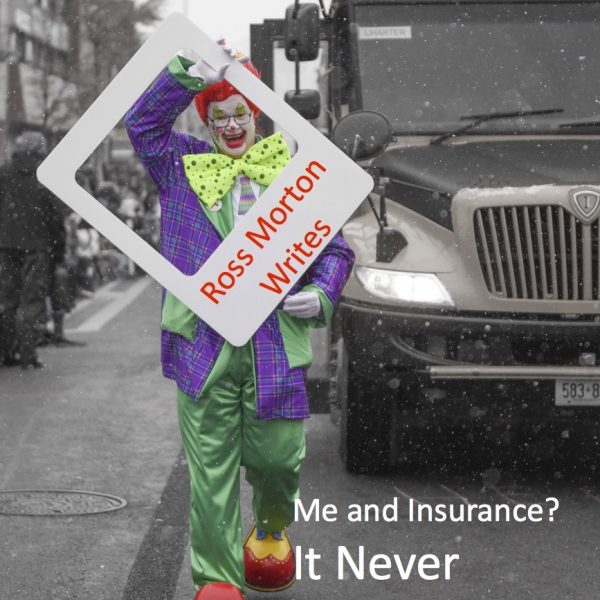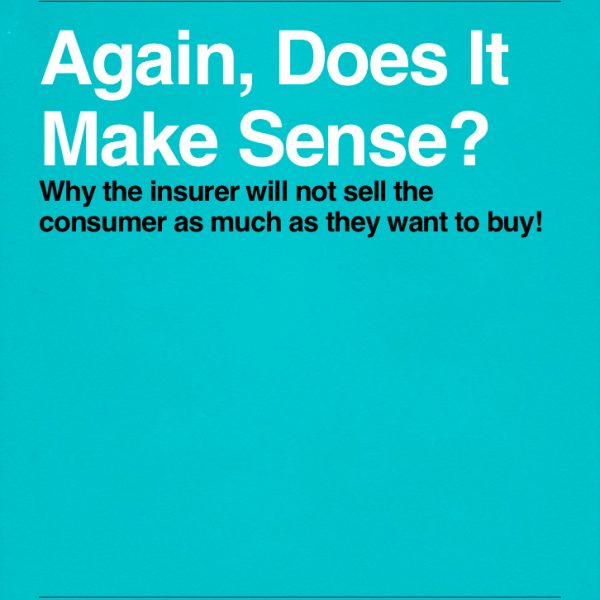What a difference three decades makes in this industry that now sells investments with a side of life and living benefit insurance. Just focusing on one aspect like reinsurance, as I am want to do since 38.5 years of my 40 years in the business was wearing a reinsurance moniker, shows a humungous change. From the closet of obscurity or the fortress of solitude to the brunt of all risk selection criticism. From the quiet instigator of new products or supplier of surplus risk cover for the junior insurers to the ratchet vehicle for lower prices (read as lower mortality assumptions) and the glad recipient of risk when assets and investments were more fun for insurers, reinsurance has changed. No one has been as confused as the broker/agent who now lives with the echoing clarion call of “the reinsurer made me do it!”
When the first signs of change occurred some 30 years ago with the reinsurers’ minor foray into everyday product design and acceptance of surplus risk, magazines like the Canadian Journal of Life Insurance and later Marketing Options rushed to find authors who could succinctly describe what reinsurance was and more importantly “who are those guys”. The major concerns of the early days of the eighties was “is it safe to place an insurance contract with a company who cedes the majority of the risk to one of them there foreign companies.” There had been reinsurance companies collapsing around the world (the fact they were marginal fly by night property and casualty reinsurers not withstanding) so the concern of the agent/broker was legit. After all they were supplying a service and product to insure the individual’s future. The fear of a policy having no value when most needed was a contingency no agent/advisor wanted to prepare for. Mud or at least the dirtiest of innuendoes were thrown at the small and mid size companies who dared use reinsurers to compete for larger cases and horror of horrors introduce all the innovative products the market was to see for a decade. It was a pillaring without a pillar of truth as large companies tried to stem the growth of those outside the family compact (decades later as we now witness the large companies are the greatest users of those same reinsurers that they pillared).
My recollection of what was worse was that the mud thrown by competing reinsurers was far worse than any mud from the insurers. It always amazed me that those “bigger” (size they believed did matter) reinsurers were hurting their own cause by fuelling a widespread fear of reinsurers totally by throwing false innuendoes about the financial security of the smaller reinsurers. The poor (emotionally strapped by fear and rightly so) agents and brokers did not know who to believe as they did not want to take any financial risk with their clients long term security. Hugh Haney was probably the first to take his favourite reinsurance personality (guess who?) with him to meet MGAs and brokers, and stand there to explain the financial integrity of the whole reinsurance industry and how it works. The reinsurer also had to explain how they could possibly take “such and such “an impairment standard or for example why the reinsurance blood pressure ratings were far less than the insurers’ ratings. The reinsurance industry was out of the closet and even actuaries stood front and centre to mollify the masses.
From obscurity to centre of fear to cause célèbre to obscurity (massively enlarged) to the perceived centre of rigid underwriting rules, decisions and the words “no” and “decline”. I think i have seen it all and expect the next phase is a conscientious drift to obscurity (in an agency advisor domain) in some respects. Reinsurers should not control the market when it comes to risk. They should support risk experimentation and flexibility especially since the science now applied to risk selection is somewhat over rated. Insurers should take more risk on specific cases and cajole the meeker reinsurers to say yes. Insurers should retain more to use as a larger stick with which to encourage the reinsurer to follow their leads on cases. In some US companies today they, the insurers, assume all of the substandard risks where the meek reinsurers stepped back from their traditional role of experimenters. Good for them as it shows that anyone can specialize in problem risks and make money at it. Knowing where the profit is hidden and how much of that profit to “give away” to salvage a case is indeed the science and art of the modern risk taker. Forcefully asking a reinsurer to follow your lead is such an empowering feeling while in reality putting the risk selection prowess back where it belongs in the insurer.
Confusion exists around when can an insurer make their own underwriting decision and when must a reinsurer(s) be asked either for opinion or approval. Most of the reinsurance in our life and living benefit world is of the automatic kind — most likely 90-95 % by risk amounts. Like the property and casualty businesses’ “treaty reinsurance” moniker, automatic reinsurance refers to all the business an insurer must cede to the reinsurer if the insurer underwrites the case and retains the agreed amount of risk themselves (often today a percentage like 25% to some maximum amount generally far short of company’s retention). The underwriting is completed by the insurer without reinsurer’s input on the particular case. The insurer’s underwriting mandate is to apply reasonable judgement on a case using the most modern of reinsurance and insurance risk selection guides and that does not mean a strict summation of a guides’ debits and credits but rather an amalgam of all and in the end an holistic decision. The exception is in the area of preferred criteria where there is no room for anything but a strict interpretation of the various preferred criteria. The only real wiggle room on preferred over and above printed pre approved wiggle room criteria by criteria is in the area of “other medical impairments” where the severity has wiggle room. Thus for the vast majority of business no insurer can say “the reinsurer made me do it!” If indeed the reinsurer made them do it, it was simply because they allowed the reinsurer to make them do it.
What is left to get us to 100% is the facultative business which takes mainly two styles, namely “excess” and “shopped”. The 5-10% is split unevenly with excess being large in risk and small in numbers of cases while shopped is large in numbers and smaller in average size. The easiest to explain is the “excess” which is when a risk size of the application for insurance (in force and applied for) exceeds what the reinsurer(s) agreed was an upper normal (easily $5 million but could for pushy companies with clout go to $30 million …) or it exceeds an industry in force and applied for maximum like $65 million. On these excess cases, the insurer is asking the reinsurer’s (s’) opinion on the risk and the reinsurer can say yea or nay. Issues on these cases are generally limited to overall industry capacity and financial justification — it passed the muster of the insurer’s underwriter but the nasty reinsurer questioned the justification and said no, maybe later with 3 years of financial statements audited by an auditing firm never involved in one of the major scandals lately and of sufficient size to be meaningful or “you haven’t got a hope in hell of getting me to say yes”.
“Shopped cases” is the nomenclature attached to those cases where the insurer has decided they do not like the risk or they know their opinion is either dated or too conservative. The case is packaged and sent to the reinsurer(s) who is being asked if they will take the risk and at what price. The reinsurer(s) is in control to make any offer they want. The insurer can then choose to accept one of the offers (generally first in with lowest quoted cost) or reject all offers. They can then tell the broker nobody wanted the risk, here is the lowest offer or heaven forbid the reinsurer quoted higher than we already quoted to you a month ago. In the exciting times, that most have forgotten about back in the seventies, there were as many as 7 reinsurers fighting in Canada to win each and every facultative case. In the USA there were up to sixteen reinsurers after some companies’ facultative business. The infighting was so tough speed often was the deciding factor. First in with lowest price! Guess what? Mistakes were made. I remember those days well and when in 1977 we audited our first 6 “wins” in the race to win Prudential of America’s facultative cases we found 5 were mistakes in our transmitting the decisions and yet there was not a friendly Pru staffer who called to ask “Are you sure you really want this risk standard when the other 13 companies declined?” Lesson learned “haste makes waste”. Imagine “winning” was what we called it when we were the lowest out of 14 reinsurers! To be fair the insurer was so awe struck by the aggressiveness of reisnurers overall they gave up questioning any out of range decision. As a reinsurer if you caught your mistake the next day we were often met with “sorry but the case was issued, printed, delivered and paid for earlier that morning.”
Today sadly there is far less interest in facultative business overall. We do not have four or five reinsurers out hustling facultative cases. The “edge” has been dulled and it is all about automatic which is not as labour intensive and apparently reaps large profits and prestige — volume of risk matters not premium in the only industry measure to rank reinsurers every year. It is just plain old fashion logic that if only one reinsurer is aggressively after reinsurance and one is sort of after only a selective facultative subset and the other is sending out an impression it wants none and the fourth has not got the depth of capacity we have less innovation and flexibility in our market for problem cases. Heck even the one does not have to be as aggressive since the facultative bar of competitiveness has been lowered. It is now interpreted as a “limbo bar” so low it scares off the unsure yet high enough to be less experimental and as aggressive as once employed.
After decades of competitive and even overly competitive or even stupid facultative assessments we now have almost nothing out there in the facultative arena. As companies relied heavily on the reinsurer to make the tough calls on those various impairments of health what they failed to realize was that they were relegating to some degree the confidence of their own underwriters to a meek and “whimpy” pusher of paper. The reinsurers, even those who fly the banners of being great facultative companies, have stripped much of the talent, confidence and innovation from the insurers which ensures their position as experts — actually became self perpetuating. The role of the reinsurer as teacher and mentor to many while building the confidence of the average insurance underwriter has been lost to the role they now play as the taker of risk only. Facultative has its downside just like anything that is overused and thus abused. The more a reinsurer can entice the insurer to send all problem or borderline problems cases their way the more the insurer’s underwriter losses their underwriting prowess and becomes dependent like a drug addict to the reinsurance facultative model. Ask any agent/broker who they think now controls underwriting and thus all risk selection.

